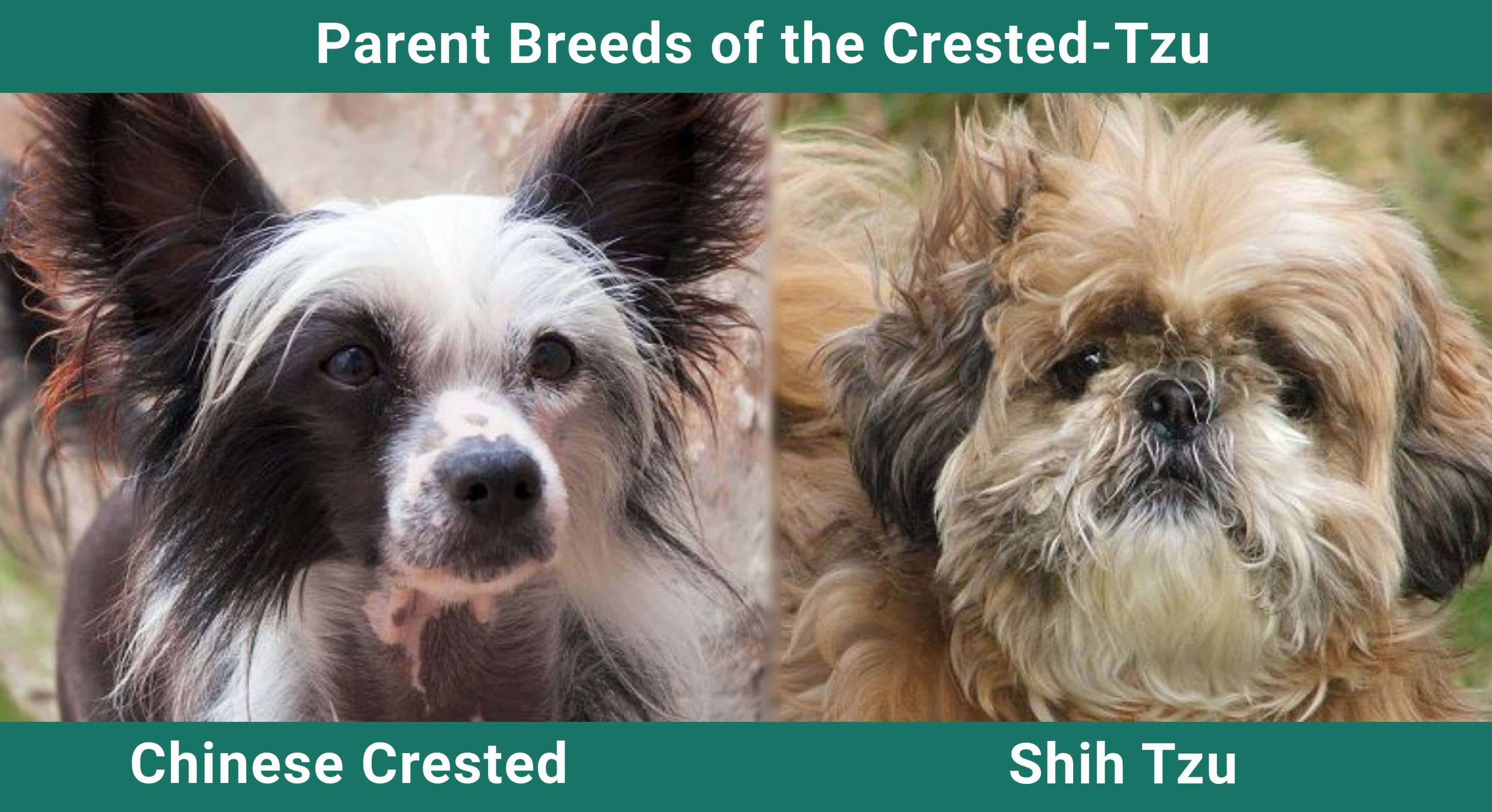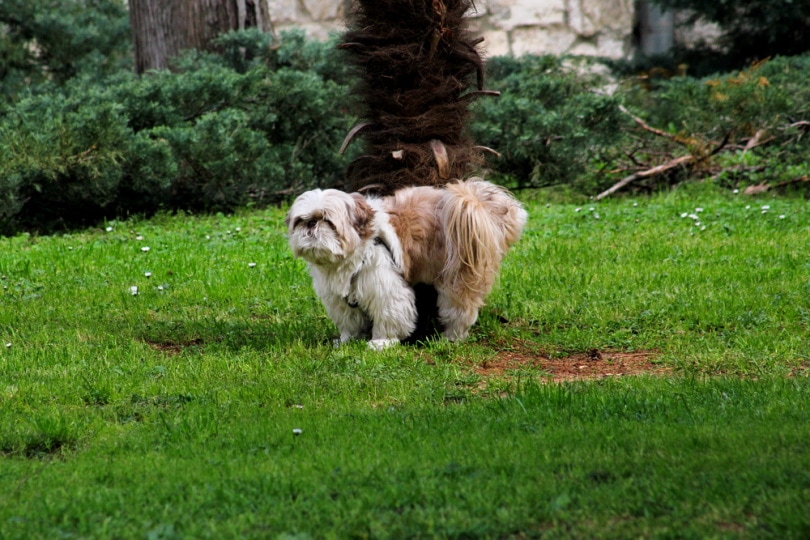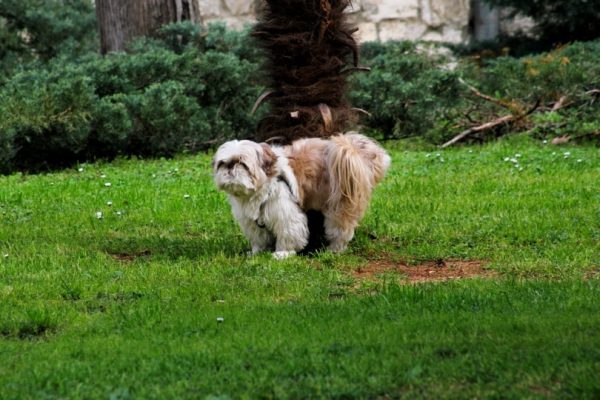Click Below to Skip Ahead
The Crested Tzu may sound like a purebred, but it is a mix between a Chinese Crested and a Shih Tzu. These dogs look very unique. If you’re looking for a canine-like no other, this may be a breed to take a closer look at.
They are typically affectionate little dogs that are very well-mannered. They are lap dogs, first and foremost. If you’re looking for a breed that will spend much of the day cuddling with you, this is a suitable option.
Breed Overview
Height:
10 – 12 inches
Weight:
9 – 15 pounds
Lifespan:
10 – 16 years
Colors:
Anything
Suitable for:
Apartment living; families with older children
Temperament:
Laidback, cuddly, people-oriented
They tend to be less yappy than other tiny dogs. They are extremely adaptable to apartment living. In fact, they are likely one of the best breeds for those living in an apartment. Their exercise needs are low, and they usually do just fine with a quick walk every day.

Crested Tzu Puppies
If you’re looking to adopt one of these dogs, you will probably spend quite a long time trying to find one. There are not many breeders who specialize in this breed, which means that puppies may be few and far between. In most cases, breeders will specialize in a purebred dog breed of some sort. However, as designed breeders become more popular, there are some that spend their time producing mixed breeds. Usually, these mixed breeds are of the doodle varieties, though, as they are the most popular. The Crested Tzu hasn’t enjoyed the same amount of attention.
Most of these puppies are the result of backyard breeders or accidental litters. You’ll have to be very careful about choosing a healthy puppy. Most of these sources do not offer a health guarantee or anything of that sort. Some may not get their puppies proper health care, which often leads to higher vet bills for you.

Temperament & Intelligence of the Crested Tzu
The Crested Tzu tends to be very people-oriented. They are affectionate and friendly with just about everyone, including strangers. They were bred largely to be companion animals, so they shine at exactly that. If you’re looking for a lap dog, then this may be a perfect breed for you.
They are decently intelligent, though this doesn’t necessarily make them the easiest dogs to train. They were bred to listen to the commands of people. Therefore, they don’t always follow what you say as well as other breeds. It isn’t that they are particularly stubborn; they just aren’t as people-pleasing as some working breeds.
This breed is very well adapted to apartment living. They have low exercise needs and aren’t very active. They usually behave very well inside with minimum training and will spend most of their day lying around. They do require some exercise, but it typically isn’t more than a short walk and a bit of playtime.
Like all dogs, this breed tends to be most active as puppies, but then they calm down sometime after their second or third year. They tend to be the most difficult to care for during puppyhood, as they can be a bit hyperactive and destructive. However, with the proper training and exercise, this breed is still far more suited to laidback living than other breeds.
They may be more prone to develop separation anxiety. We don’t have any exact statistics on the number of Crested Tzu that need professional help for separation anxiety, as this breed is rather rare. However, due to the nature of their parents, we would expect that this mixed breed might not like being left alone for long periods.
Due to their laidback nature, training them to be alone usually isn’t that difficult. Crate training at a young age can be very helpful. While these dogs are usually more than happy to simply be carried around, it is important that they gain some confidence in navigating the world on their own.
Are These Dogs Good for Families?
We do recommend this breed for families with older children. They are not typically recommended for families with younger children, as they are quite small.
Due to their smaller size, they are more likely to be injured by young children. They won’t put up with a lot of rough handling from younger children who simply don’t know any better. The Crested Tzu is also prone to becoming fearful of young children, which can result in fear-based biting. Much of dog aggression towards children is the result of fear, and this fear is usually the result of the dog being much smaller than the child.
However, these dogs can get along very well with older children. They will happily follow them around the house and cuddle on the couch. They aren’t extremely needy, though. Most are perfectly fine sitting nearby while their family members do their own thing. For this reason, we highly recommend them for laidback families who want a dog to snuggle on the couch.
Does This Breed Get Along with Other Pets?
The Crested Tzu has no problem getting along with other pets. Some socialization is required, but these dogs typically assume that everyone is their friend.
They are usually great with other dogs of all sorts. They get along with dogs that are about the same size as them, as well as canines that are much larger. They tend to be laidback and prefer other dogs that are the same. Very hyper and exuberant dogs may get on their nerves, especially if they are constantly jumping and running around them.
These dogs rarely display aggression towards other dogs, especially if they are socialized properly.
They do not have a very strong prey drive, so they usually get along with cats as well. They don’t have the same innate need to chase cats as other dogs, though that doesn’t necessarily mean that socialization isn’t needed. Like with all breeds, socializing them with a variety of different animals is important so that they learn how to interact with them properly. Otherwise, they may end up chasing cats.
It is important to note that Crested Tzus with eyes that bulge are more prone to eye damage, especially when it comes to cat claws.
Things to Know When Owning a Crested Tzu
Food & Diet Requirements
These dogs do not have any specific dietary requirements. Because of their smaller size, they may do best on food specifically designed for small dogs. This is more for practical reasons than nutritional reasons. They simply may be unable to eat larger kibble, and wet food designed for smaller dogs will have a more suitable portion size.
The Crested Tzu is prone to periodontal problems. Their mouths tend to be a bit squished. This often means that their teeth are overcrowded, leading to tartar build-up. Luckily, they do make foods that are specifically designed to combat this problem. However, teeth brushing and similar maintenance are also important; you can’t rely on food alone.
Dental food has been shown to have some effect on a dog’s oral health, so it is often recommended for this breed. Of course, speak to your vet before switching your dog to specialty food.
When these dogs are puppies, it is particularly important to feed them food designed for puppies. Because they are growing, puppies need very specific nutrients that many adult dog foods cannot provide. If puppies are not fed appropriate food, they may not develop correctly, leading to health problems later in life.
Exercise
These canines do not require much-dedicated exercise time. They are very laid back and not nearly as hyperactive as some other breeds. Often, they will spend much of their day quietly following their owners around the house and lounging on the couch. While they are smaller dogs, they don’t tend to act like smaller dogs.
However, these dogs still require daily exercise. They may not become hyperactive or destructive if they are not provided with the proper amount of exercise – like some other breeds. But they will develop obesity if they aren’t encouraged to move at least a little bit. This can cause all sorts of health problems and lead to an early death.
Often, the Crested Tzu does just fine with a short walk in the morning, followed by some playtime in the evening. This will likely work out to about 45 minutes of activity a day. The rest of the time, they will spend sleeping and quietly watching their family.
Because of their laidback nature, you can’t put these dogs in a backyard and expect them to get the proper amount of exercise. They are much more likely to lay on the porch than run around the yard. You have to take them on walks or engage them in active play.
As puppies, they may be a bit more hyperactive. But this doesn’t mean that you should force them to exercise more. Forced exercise can damage a puppy’s growing joint and bones. Puppies usually benefit most from many short exercise sessions throughout the day, usually right before they lay down for a nap. This can involve a quick play session or walk. You should never force a puppy to walk a certain distance or be active when they just want to lay down.
Training
This isn’t the easiest breed to train. They are decently intelligent, which allows them to pick up on commands with some ease. However, this doesn’t necessarily mean that they are going to actively listen to those commands when you need them to.
They aren’t necessarily as devoted and people-oriented in this manner as other dogs are. As a breed, they simply weren’t developed to listen efficiently to commands. It isn’t that they’re distractible, as is the case with some breeds. They may just not understand that they’re supposed to listen and have little internal motivation for doing so.
Luckily, these dogs don’t need a lot of training. They are usually well-behaved indoors without much training. Their laidback nature helps with this, as they spend much of their time lying around. They are not as destructive as some other breeds, even when they are puppies.
Though they are intelligent, their innate IQ isn’t so high that they need regular mental stimulation. They are often perfectly fine with short sessions of playtime and interaction with their owners. Most of the time, these dogs aren’t interested in puzzle toys or similar activities.
Grooming ✂️
Grooming is a bit complicated for this breed. It mostly depends on what traits they inherit from their parents, as this will dictate the exact type of coat they end up with. Different coat types will require different grooming. You’ll likely need to pay a lot of attention to your specific dog and change your grooming routine to match what they need.
Unlike purebred dogs, there isn’t a good overarching suggestion that works for the Crested Tzu.
If your dog is mostly hairless, they will likely need quite a few baths. Without the coat to soak up the oils from their skin, these dogs can get dingy quickly. A dog’s coat also helps them stay clean. Without it, dirt and dust won’t simply roll off.
Luckily, bathing a mostly hairless dog only takes a few minutes. You don’t have to work the soap into their fur because they don’t have a lot. They’re also rather small, so you don’t need a lot of soap, to begin with.
If your dog has more hair, then you’ll need to spend more time brushing and less time bathing. Some of these canines may need professional grooming, like a purebred Shih Tzu. For those with a full coat of hair, you should plan on brushing them out at least every few days. Otherwise, tangles and mats may develop.
Most dogs are somewhere in between these two categories. They tend to have hair on certain parts of their body and not on others. Their lower back is the last thing to get hair, while most mixed breeds have fur on at least their legs, neck, face, and tail. You’ll likely find yourself trying to strike a balance between bathing and brushing, depending on your dog’s exact amount of hair.
Because this breed has a high chance of suffering from dental disease, it is especially important that you brush their teeth. We recommend doing this at least three times a week. However, every day is also a very good option, given that dental disease affects most of these dogs.
You’ll also need to ensure that you keep an eye on their ears. They aren’t super prone to ear infections, but they can occur. If they have hair inside their ears, it can easily trap dirt and debris, causing infections.
Their nails will also need to be trimmed regularly. This should be done whenever they get too long. If you can hear their nails clanking on the floor, they are too long. You can easily do this yourself, though some dog owners prefer to have it done by a professional.
Health and Conditions
Because they are a mixed breed, these canines tend to be healthier than most. They inherit genes from a larger gene pool, which makes genetic conditions far less likely.
Most purebred dogs are at least somewhat inbred—that’s how all the purebred dogs became the same. This makes genetic conditions more common, as dogs are much more likely to inherit rare genes with health consequences. The Crested Tzu is inheriting from the gene pool of two different purebreds, though, which means that they likely won’t get any of these troublesome genes.
However, that doesn’t mean that they are completely healthy. They are prone to a few conditions that are important for dog owners to be aware of.
Patellar luxation is a particular problem in this breed. This condition is common amongst most smaller dogs. As the Crested Tzu is smaller and has two smaller parents, they may also be at a higher risk of this condition.
This disease occurs when the kneecap pops out of place. Usually, the kneecap sits in a groove on the femur, moving up and down freely as the dog walks. Sometimes, it doesn’t fit exactly in this groove and pops out. Dogs are usually seen shaking their leg out to the side to make it pop back in place.
Eye problems may be common in dogs with bulgy eyes, like the Shih Tzu. Not all Crested Tzus will have this problem, as it depends on the shape of their eye. When the eye sticks out further, it is simply more likely to get scratched or irritated.
Sunburns can happen on dogs that don’t have much hair. We recommend putting sunscreen on hairless dogs to avoid this problem.
- Eye problems
- Sunburns
- Allergies
- Pattelar Luxation
- Tracheal Collapse
- Intervertebral Disc Disease
Male vs. Female
The Crested Tzu doesn’t have many significant differences between genders. Overall, these dogs are very similar, whether they are female or male. One gender isn’t more likely to develop behavioral problems or be more affectionate. Gender has very little effect on their personality and temperament.
The one thing that gender does affect is the price of their sterilization surgery. Males tend to be a few hundred dollars cheaper than females. However, this is a one-time purchase and shouldn’t have a huge effect on your decision-making process.
This breed is so rare that it is often best not to search for a dog of a specific gender. You’ll likely find a suitable Crested Tzu much faster if you don’t narrow your potential pets to have the population.
3 Little-Known Facts About the Crested Tzu
1. This breed is extremely rare.
While mixed breeds have become more and more popular over the years, the Crested Tzu has not benefited from much of this popularity. There are not many breeders developing this mixed breed, which means puppies are often difficult to find.
2. They are not yappy.
Unlike many tiny dogs, this breed is not nearly as yappy as some others out there. They tend to be on the quiet side. Therefore, they make suitable dogs for apartments and those that are interested in quieter animals.
3. The Crested Tzu can vary widely.
As you might expect, this breed can vary widely because they aren’t purebred. When you mix two dog breeds together, you never know what traits a particular puppy is going to inherit. Therefore, they can end up very different from each other.
Conclusion
The Crested Tzu is a newer mixed breed that has yet to gain much popularity. They are a mix between a Chinese Crested and a Shih Tzu. In many cases, these dogs are laid back and calm. They aren’t yappy and hyperactive like some other tiny dogs, which makes them very suitable for apartment living. They get along great with older children and most other pets, though we don’t recommend them for those with smaller children.
Their exercise needs are fairly low. They will spend much of their time lying around the house and following their family around.
However, their grooming needs tend to be a bit complicated. It depends largely on what their coat looks like. Those with less hair will benefit from regular baths, while those with more hair will need to be brushed instead. Most dogs will be somewhere in the middle, so you’ll need to do some experimenting to figure out exactly what grooming routine benefits your dog.
If you’re looking for a lap dog, this may be a great breed for you.
- We have lots more Chinese Crested Dog Mixes and Shih Tzu Mixes in our articles!
Featured Image Credit: Zoran Photographer, Shutterstock









